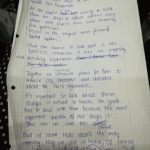Whom am I going to host? Does my partner also like rap music? Is my foreign friend willing to eat vegetarian food? These questions normally arise when the students get to know that they will take part in the exchange project. To find a fitting partner without really knowing all the students is a rather impossible task for the project coordinators. Therefore the teachers regularly request some written written application forms from the participants.
But what information should these documents include?
Allergies and aversions
The most important question is about animal allergies. You can’t match a student who is allergic to cats with a cat lover’s household even if the children would otherwise be a perfect match. That’s why we not only ask for all allergies but also for aversions for dogs, cats or other pets.
Music preferences
“Tell me which music you are listen to and I tell you who you are.” Would you really put a classical violin player with somebody who regularly listens to death metal? Rather not! It could work like a charm but it’s highly probable to get a misfit. That’s why we always want to know Continue reading “Who are you? Introducing yourself as an exchange participant”







